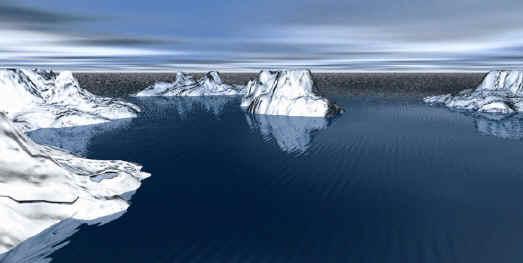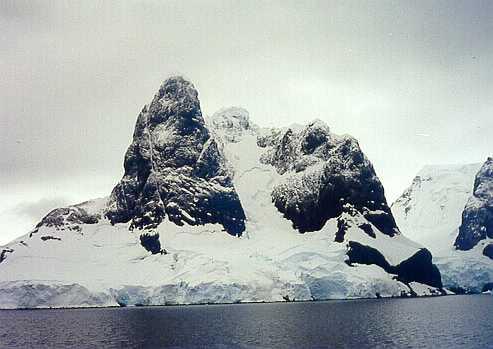Antarctica
Ship-Based Tourism
Adventure cruises are currently the most
active sector of the Antarctic tourism industry. Tourists travel,
eat and sleep on board a ship and are normally landed by inflatable
boats (helicopters are occasionally used) at a range of sites, usually
for a few hours at a time. Two to three landings are typically made
each day at different locations in some instances provided the weather
is suitable. This form of activity is now well-established, although
there is a growing trend, which commenced in the mid-1990s to provide
such 'add-ons' as sea kayaking, scuba diving, overnight stays ashore,
and brief mountaineering sojourns.
 The
focus of ship-based activities in the Peninsula area is due to the
short sea distances involved from southern South America, the relative
abundance of wildlife and spectacular scenery, and the concentration
of scientific stations. Typically it only takes two days to travel
from the ports of Ushuaia (Argentina), or Punta Arenas (Chile), to
the north-western part of the Antarctic Peninsula. Both those 'gateway'
cities have frequent, modern jet aircraft, connections to international
air networks, therefore travel to them from anywhere in the world
is relatively straight forward. Increasingly, in recent years the
Falkland Islands (Malvinas) just east of southern South American have
become a significant gateway port following improvements to the airport
there. As well as the north-west Peninsula, voyages are made to islands
such as South Georgia, the South Orkney and South Shetland Island
areas, and occasionally into the Weddell Sea.
The
focus of ship-based activities in the Peninsula area is due to the
short sea distances involved from southern South America, the relative
abundance of wildlife and spectacular scenery, and the concentration
of scientific stations. Typically it only takes two days to travel
from the ports of Ushuaia (Argentina), or Punta Arenas (Chile), to
the north-western part of the Antarctic Peninsula. Both those 'gateway'
cities have frequent, modern jet aircraft, connections to international
air networks, therefore travel to them from anywhere in the world
is relatively straight forward. Increasingly, in recent years the
Falkland Islands (Malvinas) just east of southern South American have
become a significant gateway port following improvements to the airport
there. As well as the north-west Peninsula, voyages are made to islands
such as South Georgia, the South Orkney and South Shetland Island
areas, and occasionally into the Weddell Sea.
 In contrast
to the Peninsula, visits to the Ross Sea and East Antarctic regions
are much more limited, primarily because of the greater distances
from gateway ports and the sea ice conditions normally involved. The
majority of voyages to the Ross Sea are from New Zealand (Bluff or
Lyttleton), and to a lesser extent Australia (Hobart); while the limited
number of voyages made so far to East Antarctic originate from southern
Africa, or the western part of Australia (Perth, Fremantle).
Voyages conducted in both those regions make use of visits to sub-Antarctic
islands on the way southwards and northwards to 'break' the long sea
journey. These islands include for the Ross Sea, Antipodes, Auckland,
Bounty, Campbell and Macquarie Islands south and south-west of New
Zealand, and for East Antarctica the islands of Crozet, Heard and
McDonald, and Kerguelen in the south Indian Ocean area.
In contrast
to the Peninsula, visits to the Ross Sea and East Antarctic regions
are much more limited, primarily because of the greater distances
from gateway ports and the sea ice conditions normally involved. The
majority of voyages to the Ross Sea are from New Zealand (Bluff or
Lyttleton), and to a lesser extent Australia (Hobart); while the limited
number of voyages made so far to East Antarctic originate from southern
Africa, or the western part of Australia (Perth, Fremantle).
Voyages conducted in both those regions make use of visits to sub-Antarctic
islands on the way southwards and northwards to 'break' the long sea
journey. These islands include for the Ross Sea, Antipodes, Auckland,
Bounty, Campbell and Macquarie Islands south and south-west of New
Zealand, and for East Antarctica the islands of Crozet, Heard and
McDonald, and Kerguelen in the south Indian Ocean area.
The prices of ship-based tours
vary. Tickets for the least expensive cabins range from around US $4,000
for a 9-10 day voyage in the Peninsula area (although to that must be
added air fares to Ushuaia or Punta Arenas), to US $11,000 for a voyage
to the Ross Sea from Australia or New Zealand (air fares to departure
ports are additional), and US $30,000 for a two month full Antarctic
circumnavigation (which has only occurred once to date).
Since
the improved availability of shipping and consequential sharp increase
in tourist numbers in the early 1990, the ship-based sector continues
to grow steadily. Industry predictions in 1998 estimates that by 2003
some 14,000 people will visit the Antarctic continent, the majority
of them by ship.



